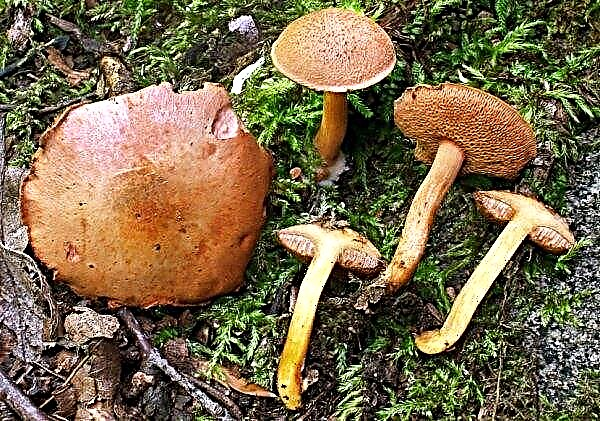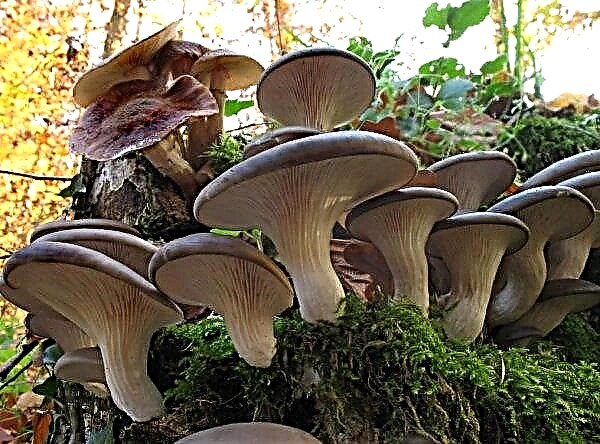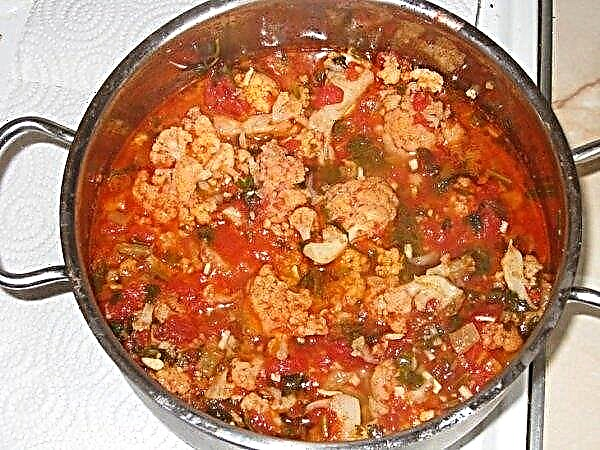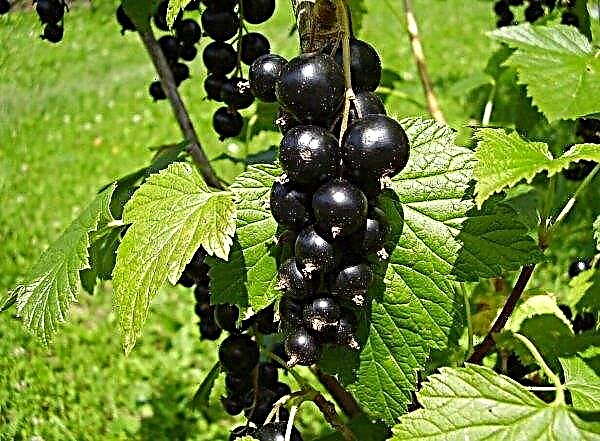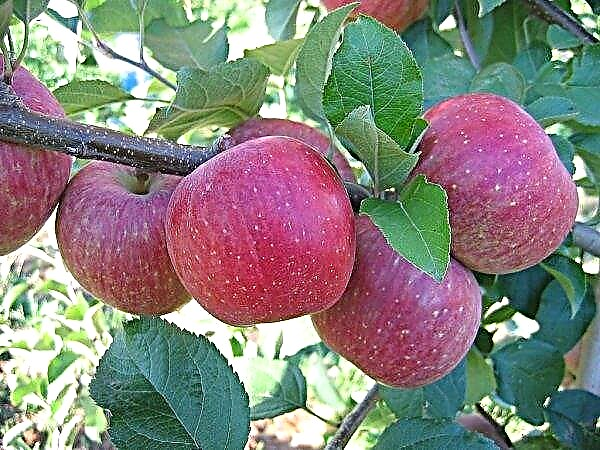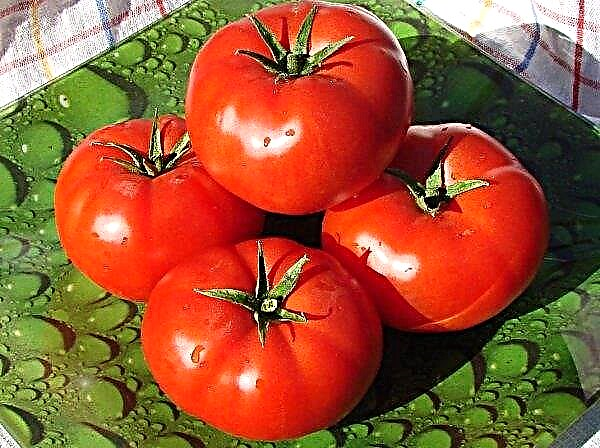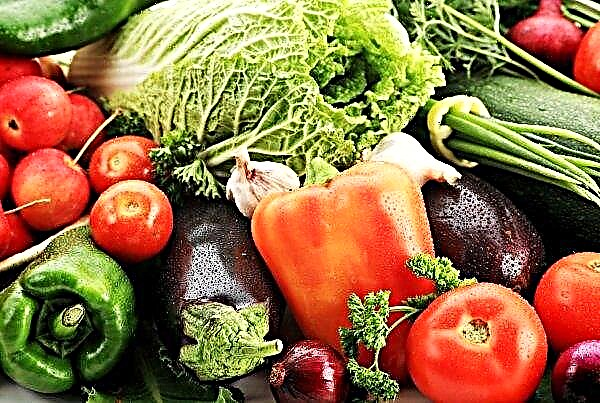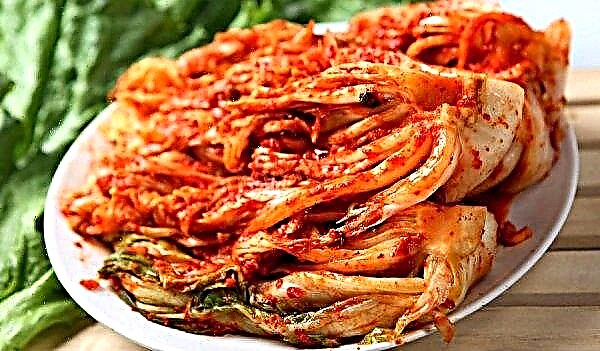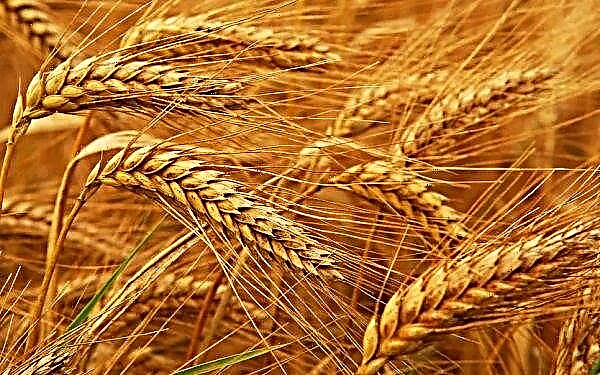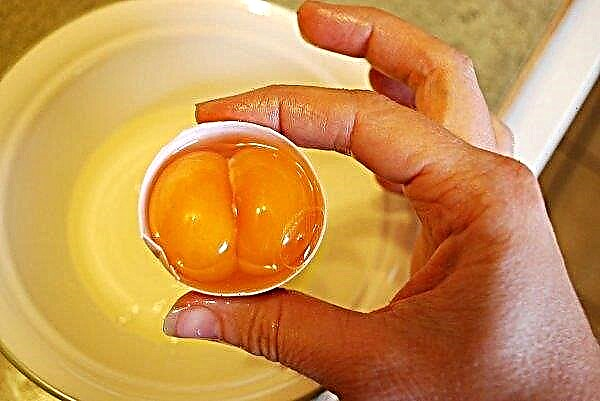One of the ten most popular and popular varieties for growing tomato varieties includes the Mazarini tomato, which is difficult to resist for those who prefer large-fruited vegetables. In addition to its large size, the tomato boasts a very delicate taste without sourness and high productivity. How to plant Mazarini tomatoes correctly, and how to care for them, let's figure it out.
Grade description
Tomato "Mazarin" is a hybrid variety of indeterminate type, with unlimited growth of the main stem. It is suitable for growing in greenhouses or in southern regions where a warm and humid climate prevails.
Did you know? Tomatoes can improve mood. The thing is that in their composition they contain serotonin - the "hormone of happiness", which is present in bananas and dark chocolate.
The variety is distinguished by such characteristics:
- early ripening, the first crop can be harvested 95–115 days after transplanting;
- high-speed tomato, stem height can reach 1.8–2 m. The bush requires garter and formation into one stem;
- the leaves are lush, rather large, with a slight edge on the surface;
- flower brushes are formed over 8–9 leaves, then every 2. From 3 to 6 fruits can ripen on one brush;
- yields are good, although not the largest among the group of early ripe, large varieties. With 1 sq. m, subject to the rules of agricultural technology, you can collect about 14 kg of fruit;
- tomato fruits have a heart-shaped, bright raspberry saturated color. On average, the weight of one reaches 500–600 g. They have a pleasant, very delicate taste without sourness, and a pronounced tomato aroma;
- the pulp is tender, juicy, with a small amount of seeds;
- the peel is thin, but resistant to cracking, has a good keeping quality;
- the variety has a long fruiting period and is able to bear fruit before the onset of the first frost;
- "Mazarini" is characterized by good resistance to traditional diseases that affect all tomatoes;
- suitable for growing in greenhouses and on open fields in regions with a warm climate;
- the fruits are used for the preparation of salad preservation, ketchups, sauces, tomato paste, salting in large containers, as well as for fresh consumption.

Advantages and disadvantages
Variety "Mazarin" is the result of the work of Russian breeders.
- It has the following advantages:
- early ripening and a long fruiting period;
- high yields;
- resistance to drought, the ability to bear fruit at a temperature of about 40 ° C;
- good adaptation to environmental conditions;
- resistance to ailments that can affect solanaceous;
- good keeping quality of fruits and their transportability;
- The tomato is unpretentious in care and suitable for growing by beginner gardeners;
- excellent taste of fruits, the possibility of using them for the preparation of salads, salad preparations for the winter.
- Meanwhile, the tomato is not without flaws:
- the inability to make whole-fruit preservation due to the large size of the fruit;
- the need for a garter and bush planting;
- dependence of fruit taste and tomato yield on environmental conditions, in particular, temperature and humidity.
How to grow tomato seedlings yourself
The best option is to plant the tomato "Mazarin" in a greenhouse or open ground in the form of seedlings, which can be grown independently.
Optimal timing
Specialists recommend planting seeds for seedlings in late February - early March. Seeds should be purchased in specialized stores, since the hybrid variety and get seed material from previously harvested tomatoes will be quite difficult.
Soil mix
For planting seeds, it is necessary to prepare a light, nutritious soil mixture with neutral acidity, the components of which can be humus and earth from the garden, taken in equal proportions. It is possible to enrich the soil with wood ash and superphosphates.
As a soil for future seedlings, a mixture of black soil, fine river sand and purchased land, mixed in a ratio of 1: 1: 1, is also suitable.
Before sowing seeds, the soil must be disinfected from possible parasites and pests.
There are several ways to do this:
- warm the soil in the oven for 15–20 minutes, at a temperature of 180–200 ° C;
- Pour the soil with a concentrated solution of potassium permanganate and allow it to dry.
Important! If a purchased soil mixture is used for sowing, it is not necessary to disinfect it.
Capacity for growing
For growing seedlings, you can use any containers that are on the farm. As a rule, disposable plastic cups, boxes, cardboard boxes are used. For the convenience of working with seedlings, you can purchase special boxes - cassettes. Peat tablets, which are subsequently planted in the ground along with seedlings, will be an ideal option.
Peat tablets, which are subsequently planted in the ground along with seedlings, will be an ideal option.
Seed preparation
It is recommended that you buy Mazarini tomato seeds only in trusted, specialized stores, then you will not have to disinfect the material.
When buying seeds in the markets "by weight", you should:
- Check them for germination. Pour the seeds with cold water, set aside for half an hour: high-quality grains will settle to the bottom of the tank, empty ones will remain floating on the surface.
- To carry out disinfection. Prepare a solution of 0.5 g of soda and 100 ml of water, dip the seeds into it and let stand for about a day. You can also soak the seeds overnight in a weak solution of potassium permanganate.
Important! Seed disinfection will make it possible to destroy possible pests, and will also strengthen the sprouts' immunity, improve the fertility of the plant and its productivity.
Sowing seeds
Sowing seeds is carried out in the traditional way:
- soil is poured into a seedling container and small holes are made in it, up to 0.5 cm. Some gardeners recommend sowing seeds without a hole, simply sprinkling them with soil;
- Sowing is carried out according to the scheme: between grooves not less than 3-4 cm, between seeds - 1-2 cm.
After disembarkation, the soil must be moistened with a spray gun. When the soil settles, the container with the seed should be covered with plastic wrap and placed in a warm, dry place. With the appearance of the first leaves, seedlings need to be dived into separate pots, if it was grown in boxes or disposable cups.
Seedling Care
To sprouts were strong and powerful, they need to provide comfortable conditions for growth and development:
- A place: It is recommended to place the seedlings in a warm place, where there are no drafts, direct sunlight and sharp jumps in temperature.
- Temperature: The optimum temperature indices are considered to be 22–24 ° С, at which the first sprouts can appear within 5–6 days after planting. Humidity should be maintained at average values.
- Lighting: it is preferable to organize the plant a 12-hour daylight. On cloudy days or when there is a lack of natural lighting, it is necessary to install additional light sources in the form of fluorescent lamps.
- Watering: It is recommended to moisten the soil as it dries using a spray gun. Do not allow the soil to dry out, or vice versa, its excessive moisture.
- Top dressing: about two weeks after the germination of the first sprouts, the soil must be enriched with fertilizers, which should subsequently be applied regularly, every week. As a top dressing, liquid products based on potassium and phosphorus are suitable.
Did you know? Doctors say that constant consumption of tomatoes reduces the risk of cancer.
Seedling hardening
To make the plant easier and faster to adapt to environmental conditions after it has been planted in a permanent place, experts recommend that it be quenched without fail. For this:
For this:
- a few weeks before planting in a room with seedlings, it is necessary to lower the temperature to 12-15 ° C;
- temperature indicators should be gradually reduced so that 5-6 days before planting in the soil they are equal to the ambient temperature;
- at the same time, the root system should be hardened by reducing the number of irrigations. At the same time, the volume of irrigation should be left unchanged, and only the intervals between soil moisture should be increased;
- 1-2 days before planting, it is recommended that the container with seedlings be taken out to fresh air - for example, to the balcony - and left for several hours. On the eve of planting in the soil, seedlings must be left in the air for the whole night.
Planting seedlings in a permanent place
Planting seedlings in open ground or in a greenhouse should be carried out on 55-60 days after germination of sprouts, approximately in late May - early June. Since the plant belongs to tall varieties, planting should be carried out according to this scheme: per 1 square. m no more than 3 bushes.
Important! Close planting negatively affects the development of the bush and leads to a decrease in productivity.
Before disembarking, it is necessary to prepare the soil:
- loosen the soil thoroughly, moisten;
- to fertilize: for each well - 1 tbsp. spoon of superphosphate and potassium sulfate.
Immediately after planting, the bushes must be tied up.
How to care in the open ground
One of the main advantages of the Mazarini variety is its unpretentiousness in care, which consists in:
- timely watering and top dressing;
- circumcision of stepsons;
- weeding weeds;
- decontamination of bushes from pests and diseases.
Watering
After planting seedlings, the first watering should be carried out after 1.5–2 weeks, depending on natural conditions, and then - as the soil dries. Excessive soil moisture must not be allowed, otherwise the root system will suffer.
Excessive soil moisture must not be allowed, otherwise the root system will suffer.
As part of greenhouse cultivation, experts recommend organizing drip irrigation, through which plants will receive as much moisture as necessary.
For irrigation, you should use settled water at room temperature, which is poured directly into the wells, under the bush, at the rate of 0.8–0.9 liters per plant. It is mandatory to water during the flowering period of the plant and the formation of fruits, after loosening the soil, under the earthing up (if it is carried out).
Top dressing
Throughout the season, the vegetable must be fed regularly up to four times using organic and mineral products. The interval between fertilizers should be 2-3 weeks. Experts recommend applying dressing immediately after loosening the soil, weeding the weeds, as well as in the phase of formation and development of the fruit.
Important! If the plant begins to intensively grow green mass, it is necessary to reduce soil moisture for a while, as well as to introduce phosphate fertilizers, which will activate the growth of fruits.
Stepson
A prerequisite for the cultivation of tomatoes "Mazarini" is considered to be stalking of the stem. Removing lateral little stepsons up to 3-4 cm in size can increase the yield of the bush and achieve large fruit sizes. It is recommended to form a bush in one stalk, while leaving 2-3 brushes.
Every week, lateral processes that remove nutrients from the fruit should be removed. You also need to remove several pieces of the bottom sheets every 10 days.
Soil care
For a rich tomato crop, weed should be periodically weeded from the weeds and the soil loosened.
The latter will allow:
- saturate the earth with oxygen and activate the flow of nutrients to the root system, thereby improving tomato growth;
- create favorable conditions for warming the soil.
The first loosening should be carried out after planting seedlings, delving into the soil by 10–12 cm. The second and subsequent loosening should be carried out after each moistening of the soil, after drying of the soil, to a depth of 4–5 cm. Weeding is recommended at the same time.
To prevent the appearance of weeds, you can mulch - cover the bed with various materials of organic and inorganic origin, for example, straw, sawdust, sand.
In addition to the fact that mulch will serve as an excellent prevention of weed growth, it will allow:
- keep moisture in the soil;
- prevent the evaporation of water from the surface of the soil;
- simplify the process of watering seedlings.
Bush tying
Immediately after planting, it is recommended to garter bushes using long wooden pegs or trellis. Pegs should be inserted into the ground on the north side of the bush at a distance of 10 cm from the stem. With a strong, but not rigid rope, you need to tie up the vegetation.
Garter trellis will be the best option for large beds. In this case, in the ground, with an interval of 4 m, you need to place wooden or plastic pegs, between them pull a rope to which you should tie the bush. Plant binding must be carried out necessarily, since it will protect the bush from rotting, as well as diseases that can develop due to the contact of greenery with moist soil.
Plant binding must be carried out necessarily, since it will protect the bush from rotting, as well as diseases that can develop due to the contact of greenery with moist soil.
Preventative treatment
Although this variety is resistant to solanaceous diseases, if the rules of agricultural technology are not followed, the vegetable can be affected: late blight, tobacco mosaic, gray spotting, etc.
For the prevention of diseases, a number of activities should be regularly performed:
- do not allow excessive soil moisture. In this case, it’s better to underfill than to overfill;
- do regular loosening of the soil, digging it and weeding the weeds;
- systematically ventilate the greenhouse, prevent dampness or drafts;
- make fertilizers on time;
- Do not get involved in nitrogen-based fertilizers, as they lead to a massive discharge of ovaries and the development of certain diseases;
- periodically treat the bushes with biological products, for example, Fitosporin, which protects the vegetable from viruses and fungus.
For the prevention of parasites and ailments, folk remedies are often used.
The plant is treated:
- garlic water or whey - from late blight;
- soapy water - from aphids;
- ammonia solution - from slugs;
- potassium permanganate solution - from tobacco mosaic.
 The hybrid Mazarini tomato is worthy to become a regular guest in the beds of domestic gardeners. The variety is characterized by undemanding care, ease of cultivation, excellent taste of fruits and their wide scope of use.
The hybrid Mazarini tomato is worthy to become a regular guest in the beds of domestic gardeners. The variety is characterized by undemanding care, ease of cultivation, excellent taste of fruits and their wide scope of use.Did you know? There is still much debate about the biological definition of tomatoes. So, in the USA in 1893, tomatoes were recognized as vegetables, since they, although they are formed from seeds, like fruits, are not used as a dessert. And here The European Union in 2001 decided to rank tomatoes as fruits.
Observing the usual rules of agricultural technology, even novice gardeners will be able to get a rich harvest of tasty and wholesome fruits.

